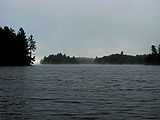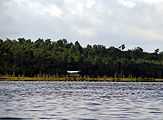Lows Lake (New York)
| Lows Lake | |
|---|---|
 Low's Lake, looking southwest from Grass Pond Mountain | |
| Location | St. Lawrence / Hamilton counties, New York, US |
| Coordinates | 44°06′31″N 74°40′21″W / 44.10861°N 74.67250°WCoordinates: 44°06′31″N 74°40′21″W / 44.10861°N 74.67250°W |
| Type | reservoir |
| Primary inflows | Bog River Flow |
| Primary outflows | Bog River Flow |
| Basin countries | United States |
| Surface elevation | 1,762 ft (537 m) |
Lows Lake is a reservoir in the Adirondack Park in northeastern New York. It is located in the Five Ponds Wilderness Area, 10 miles (16 km) southwest of Tupper Lake. The lake is part of the Bog River Flow. While it is largely surrounded by New York State Forest Preserve, the northeast shore is privately held, along with a few small parcels that border the lake. The lake lies within the towns of Colton, Clifton, and Long Lake.
The lake was named after Abbot Augustus Low, son of Abiel Abbot Low; Low owned 40,000 acres (160 km2) in this vicinity early in the 20th century. Low constructed two hydroelectric dams along the eastern portion of the Bog River Flow; the upper dam, where most of Low's main buildings were located, created Lows Lake. On the granite ledge above the second dam, there is a plaque commemorating the Low's memory. His ashes were spread from the ledge.
Sabattis Scout Reservation owns a portion of the lake with three islands and has a Boy Scout camp located near the mid-eastern and northern portion.
Grass Pond Mountain, 2,240 feet (680 m), lies directly north of the lake and has expansive views from its summit. Graves Mountain, 2,300 feet (700 m), is named after a 19th-century hunter from Tupper Lake; its southern flank was eroded after the forest fire of 1906, exposing a large granite face; a survey marker is located at its peak.
"Horsehead Island", actually a floating bog, was located at the western end of Lows Lake for many years. In the 1980s a large portion separated from the mass and now sits halfway easterly in the lake near a campsite known as Boone's landing. The bog is filled with an impressive number of large pitcher plants and other bog plant material.
The western end of Lows Lake lies deep within the proposed Adirondacks "Bob Marshall Wilderness", (there is another in Montana). At the western end of the lake is a three and one-half mile carry to the Oswegatchie River. This trail passes by a huge blowdown from 1995, Big Deer Pond and a long esker before reaching the upper source of the Oswegatchie River. There is a large beaver dam, followed by the Big Deer Pond outlet north approximately 1/4 mile to the St. Lawrence-Herkimer-Hamilton county marker. Slightly south of the marker stands what is purportedly the widest White Pine in the Adirondacks.
A controversy arose in 2008 over the use of floatplanes on Lows Lake, when the New York State Department of Environmental Conservation proposed allowing them to land on the lake for an additional ten-year period; under the 2003 Bog River Complex Unit Management Plan, DEC and the Adirondack Park Agency had agreed that floatplanes would be banned starting in January, 2008. [1] Ultimately, the APA has decided to classify the lake as Wilderness, which will exclude floatplanes starting in 2011.[2] Much of the controversy arose about Lows Lake being a 'man-made' (Reservoir) lake with private property ownership on some of its perimeter.
In June 2012, opponents of the wilderness classification argued that the APA did not have the authority to classify the lake as wilderness because New York state does not own the entire shoreline of Lows Lake. But Lynch had found that "the APA Act and the (Adirondack Park State Land Master Plan) require the APA to classify State owned bodies of water even if the water is contiguous to a private land holding." The decision affirmed that state-owned lakes and other water bodies in the Adirondack Park are part of the constitutionally protected Forest Preserve and must be managed in accordance with the APSLMP. The ruling placed a deep cut in revenues of the last two remaining float-plane operators in the Adirondacks, along with collateral businesses that served them.
-

The east end of Lows Lake has a number of Islands
-

A whitetail deer on the shore of Lows Lake
-

A floatplane lands on Lows Lake